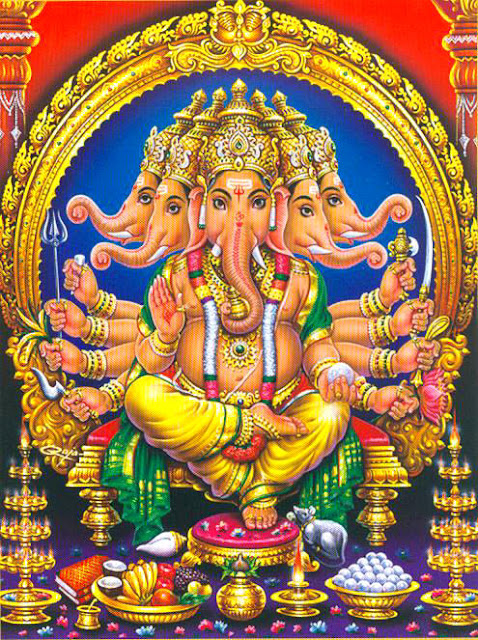Skanda Shasti which is a very important festival in our Hindu Religion started today .
Observing fasting with milk or fruits or being vegetarian is important .
Below is some information for you to understand about this important festival
Skanda Sashti, also known as Kanda Shashti, is a festival dedicated to Lord Muruga. Sashti, meaning sixth day, falls on the sixth day of the full moon and the sixth day of the new moon in the Hindu calendar. However, Skanda Sashti is a six-day festival and is observed once in a year. It falls after Diwali in the Tamil month of ‘Aippasi’ (October - November), starting from the ‘piratamai’, the 1st phase of the brightening moon. The festival commemorates the slaying of the demon, Soorapadman, by Lord Subramanya, and is celebrated with great pomp and splendor. In 2012, Skanda Shasti begins on 14th November 2012 and ends on 20th November 2012 with Tirukalyanam (the sacred wedding).
Legend behind Skanda Sashti
Kanda Shashti is associated with the birth of Lord Muruga who defeated the evil powers. According to legends, Soorapadma, a powerful demon, was harassing Devas and mankind. The helpless Devas pleased Lord Shiva to relieve them from the demon. As a result, Lord Shiva produced six powerful sparks of fire from His third eye called Netrikkan. This was carried by Lord Vayu (god of air) and Lord Agni (god of fire) to river Ganges who in turn took to Saravana Poygai, a holy pond. These sparks became six divine small male babies who were nursed by six Karthigai pengal. Goddess Parvati hugged the kids and made them into a single child with six faces and twelve hands, called Shanmughan. Nine shaktis appeared from Goddess Parvati’s anklets from where Veerabahu and numerous soldiers emerged. They became the warriors of Lord Murugan. Lord Shiva granted Lord Murugan, a vel (spear) called Vetrivel and also gifted him with eleven Rudras which were changed into eleven arms.
According to legends, Soorapadma, a powerful demon, was harassing Devas and mankind. The helpless Devas pleased Lord Shiva to relieve them from the demon. As a result, Lord Shiva produced six powerful sparks of fire from His third eye called Netrikkan. This was carried by Lord Vayu (god of air) and Lord Agni (god of fire) to river Ganges who in turn took to Saravana Poygai, a holy pond. These sparks became six divine small male babies who were nursed by six Karthigai pengal. Goddess Parvati hugged the kids and made them into a single child with six faces and twelve hands, called Shanmughan. Nine shaktis appeared from Goddess Parvati’s anklets from where Veerabahu and numerous soldiers emerged. They became the warriors of Lord Murugan. Lord Shiva granted Lord Murugan, a vel (spear) called Vetrivel and also gifted him with eleven Rudras which were changed into eleven arms.
Lord Murugan came to Thiruchendur with group and pursued war against Soorapadman which lasted for six days. He defeated the demon on the sixth day and this day is called as Skanda Sashti. The Lord converted Soorapadma into a peacock and a cock. The peacock or Mayil became the vehicle of Lord Murugan and therefore He is also called Mayilvahanan (or Mayil Vahanan – which means the one who uses Peacock as his vehicle). Seval or cock adorned his flag. Lord Muruga then married Deivayanai or Devasena who is the daughter of Indra (the Lord of Devas).
Legend behind Skanda Sashti
Kanda Shashti is associated with the birth of Lord Muruga who defeated the evil powers.
 According to legends, Soorapadma, a powerful demon, was harassing Devas and mankind. The helpless Devas pleased Lord Shiva to relieve them from the demon. As a result, Lord Shiva produced six powerful sparks of fire from His third eye called Netrikkan. This was carried by Lord Vayu (god of air) and Lord Agni (god of fire) to river Ganges who in turn took to Saravana Poygai, a holy pond. These sparks became six divine small male babies who were nursed by six Karthigai pengal. Goddess Parvati hugged the kids and made them into a single child with six faces and twelve hands, called Shanmughan. Nine shaktis appeared from Goddess Parvati’s anklets from where Veerabahu and numerous soldiers emerged. They became the warriors of Lord Murugan. Lord Shiva granted Lord Murugan, a vel (spear) called Vetrivel and also gifted him with eleven Rudras which were changed into eleven arms.
According to legends, Soorapadma, a powerful demon, was harassing Devas and mankind. The helpless Devas pleased Lord Shiva to relieve them from the demon. As a result, Lord Shiva produced six powerful sparks of fire from His third eye called Netrikkan. This was carried by Lord Vayu (god of air) and Lord Agni (god of fire) to river Ganges who in turn took to Saravana Poygai, a holy pond. These sparks became six divine small male babies who were nursed by six Karthigai pengal. Goddess Parvati hugged the kids and made them into a single child with six faces and twelve hands, called Shanmughan. Nine shaktis appeared from Goddess Parvati’s anklets from where Veerabahu and numerous soldiers emerged. They became the warriors of Lord Murugan. Lord Shiva granted Lord Murugan, a vel (spear) called Vetrivel and also gifted him with eleven Rudras which were changed into eleven arms.Lord Murugan came to Thiruchendur with group and pursued war against Soorapadman which lasted for six days. He defeated the demon on the sixth day and this day is called as Skanda Sashti. The Lord converted Soorapadma into a peacock and a cock. The peacock or Mayil became the vehicle of Lord Murugan and therefore He is also called Mayilvahanan (or Mayil Vahanan – which means the one who uses Peacock as his vehicle). Seval or cock adorned his flag. Lord Muruga then married Deivayanai or Devasena who is the daughter of Indra (the Lord of Devas).
Please forward to all you friends.
Om Tat Sat Om
Anbe Sivam
Sivajnani Nagappan
012 9259495
artha.dharma@gmail.com










